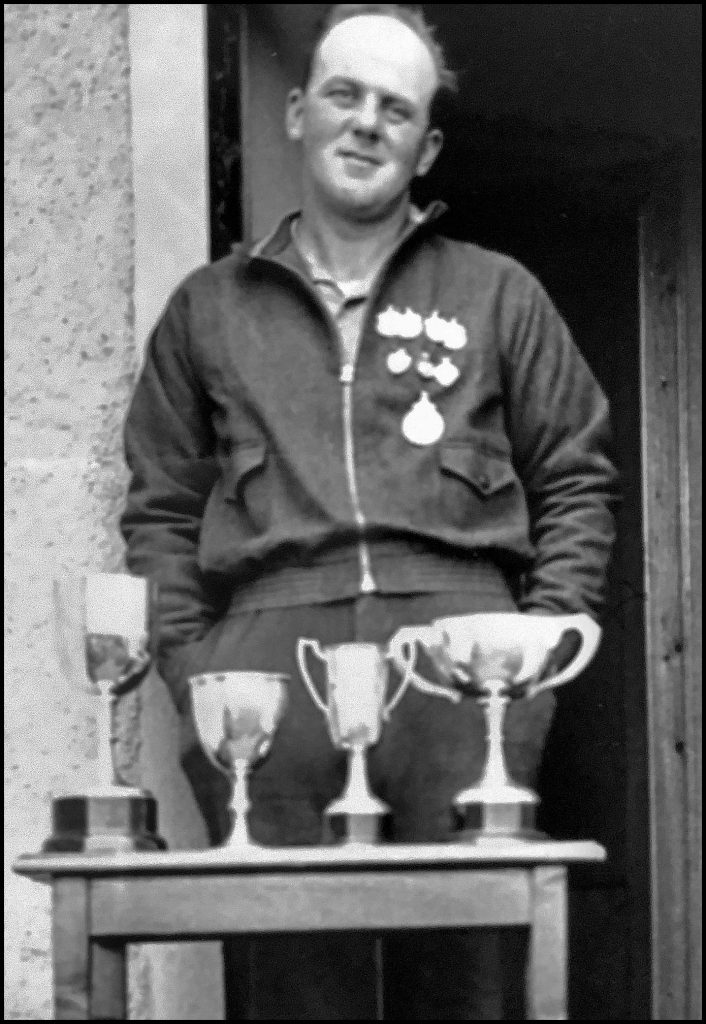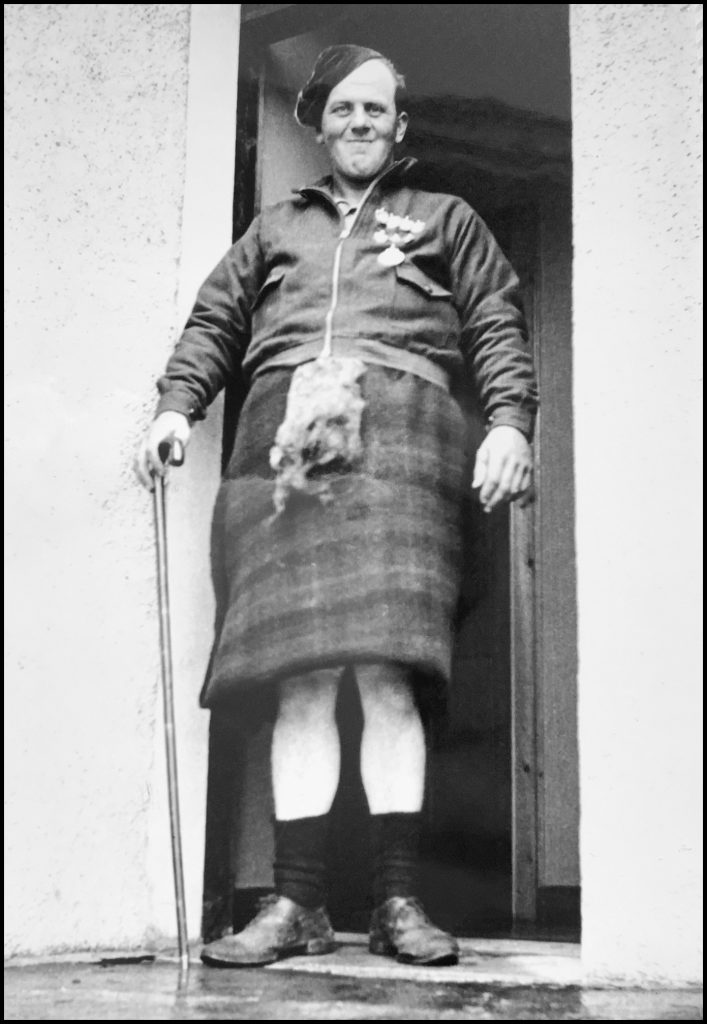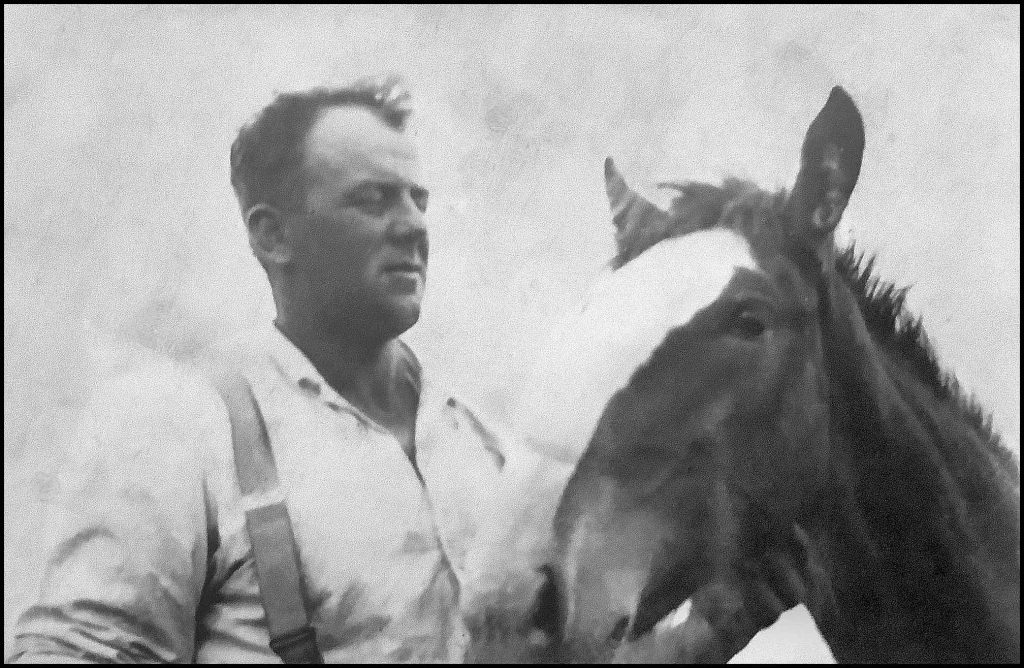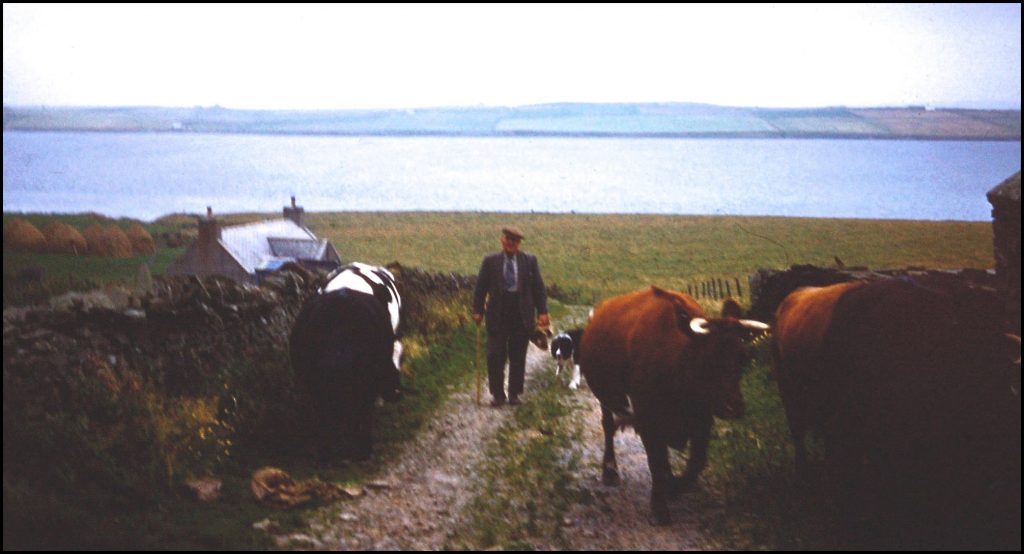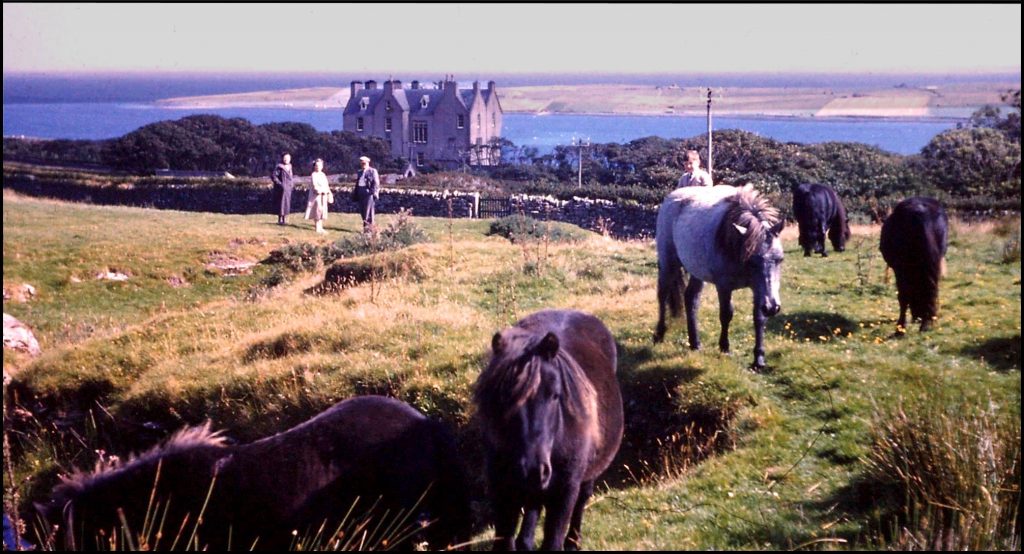by
Margaret Green

The Johnstons had farmed Crook, Rendall, for three generations – but soon after the First World War the farm was sold from under them. They had to find another tenancy and moved to Trumland – James Halcro Johnston, his wife Maggie, his two unmarried sisters Maggie and Clara (who lived at the Old Mill) and three teenage children, Bobby, James William, and Violet.
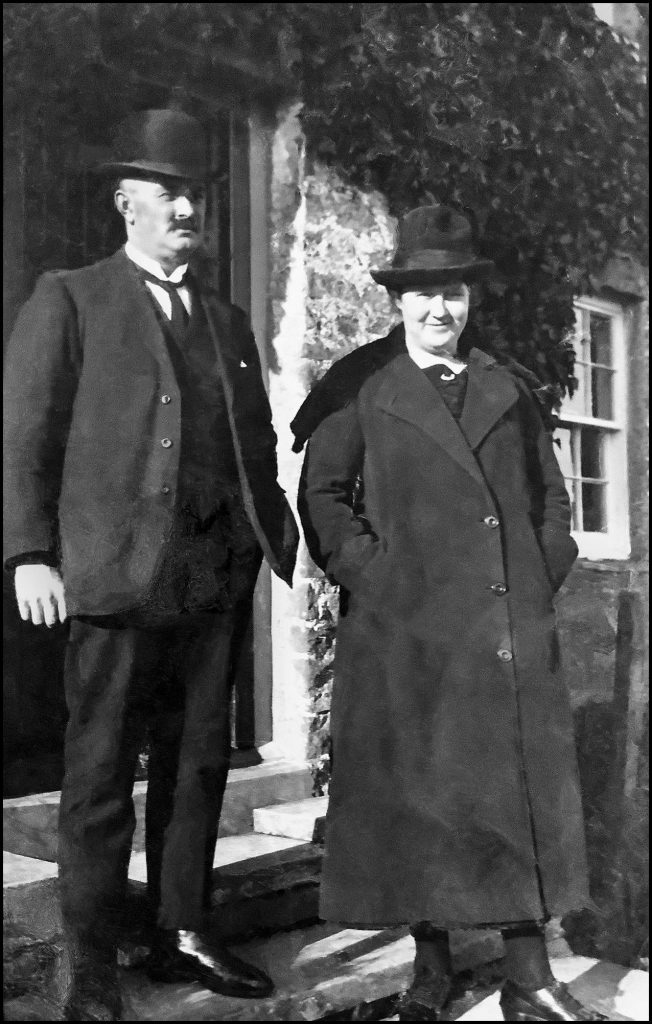
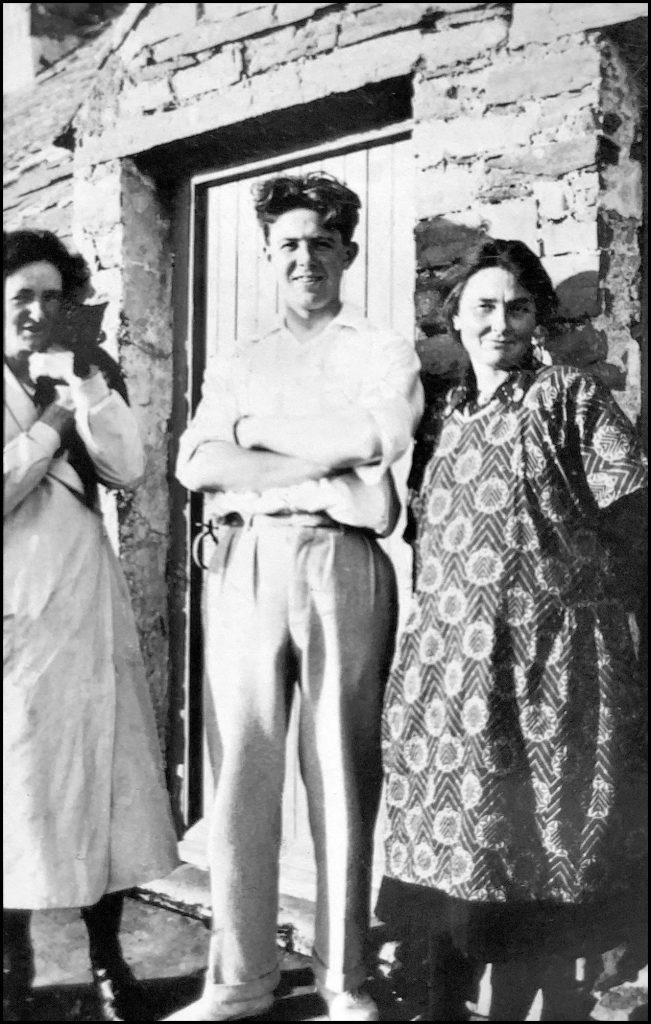
James took great pride in exhibiting livestock at the annual Rousay Agricultural Society Show. In 1926 he won a number of prizes in all classes of cattle, but it was his Clydesdale mare which won him the highest accolade – the Highland and Agricultural Society of Scotland’s medal for Best Mare in Yard. Below is a cuting from the Orkney Herald describing the event, and a photo of the actual medal – courtesy of Signy Spence, James’ great-great granddaughter.
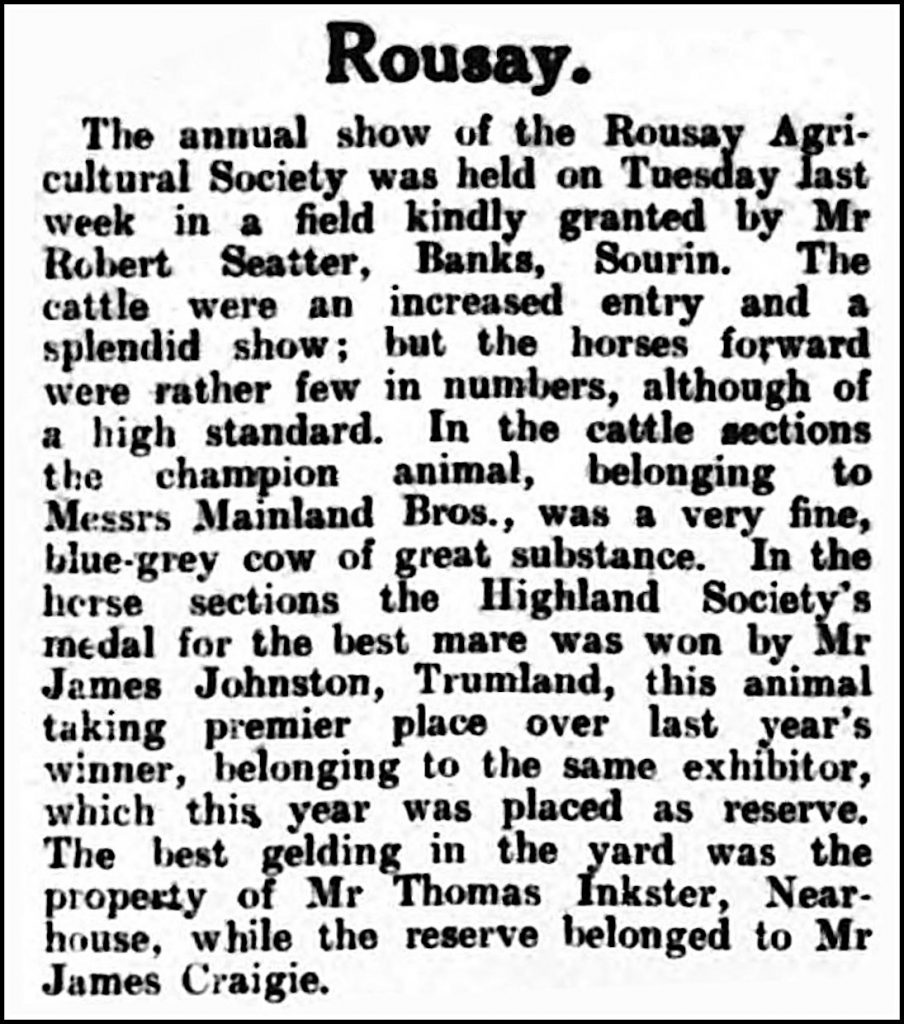
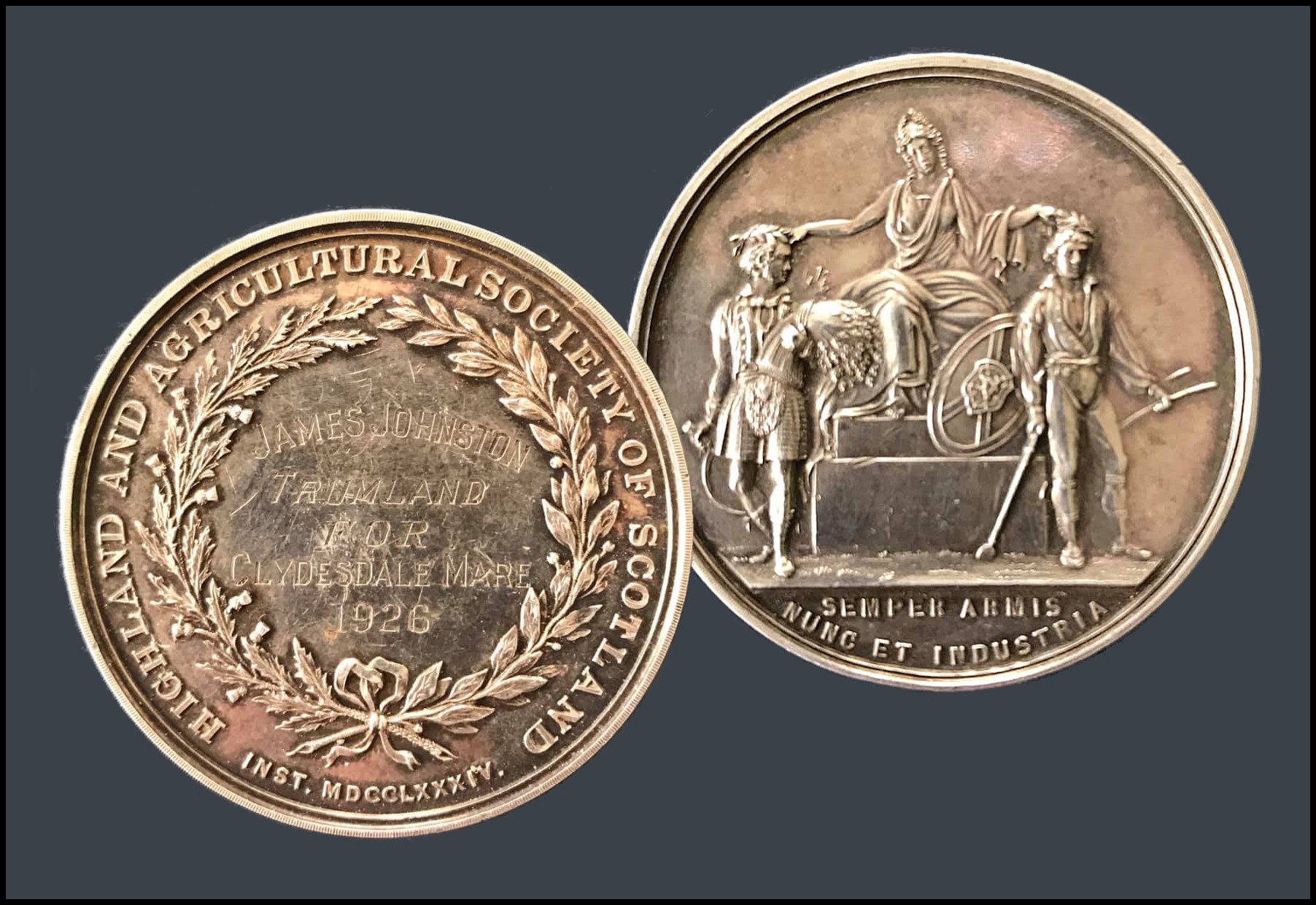

Margaret Green, daughter of James William and his wife Johan, has been kind enough to submit the following for inclusion on Rousay Remembered:-

This is James William’s story. Passages in italics are verbatim from his 90th birthday speech:-
My father had a strong musical bent. He played the fiddle at the local dances. He led the praise in church where there was no organ. He could strike the key of his tuning fork and read the tonic sol-fa at a glance. He participated in the concerts in aid of the Red Cross during the war, and my Uncle Jamie once told me he could be heard whistling all day long in the fields. He was a man of very deep feeling, and always in tears when I was leaving home in later life.
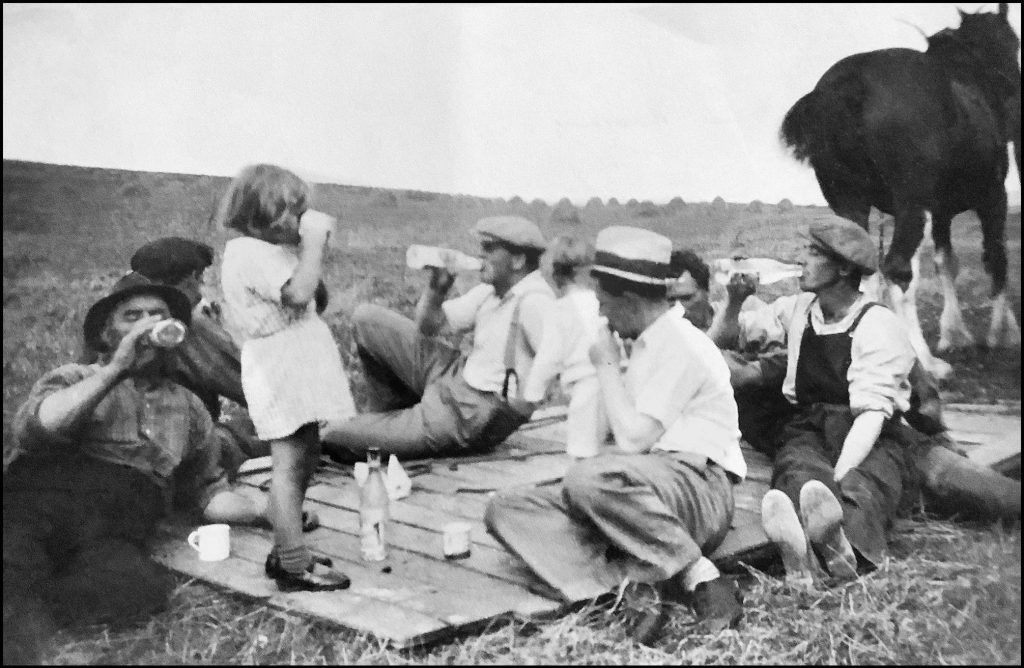
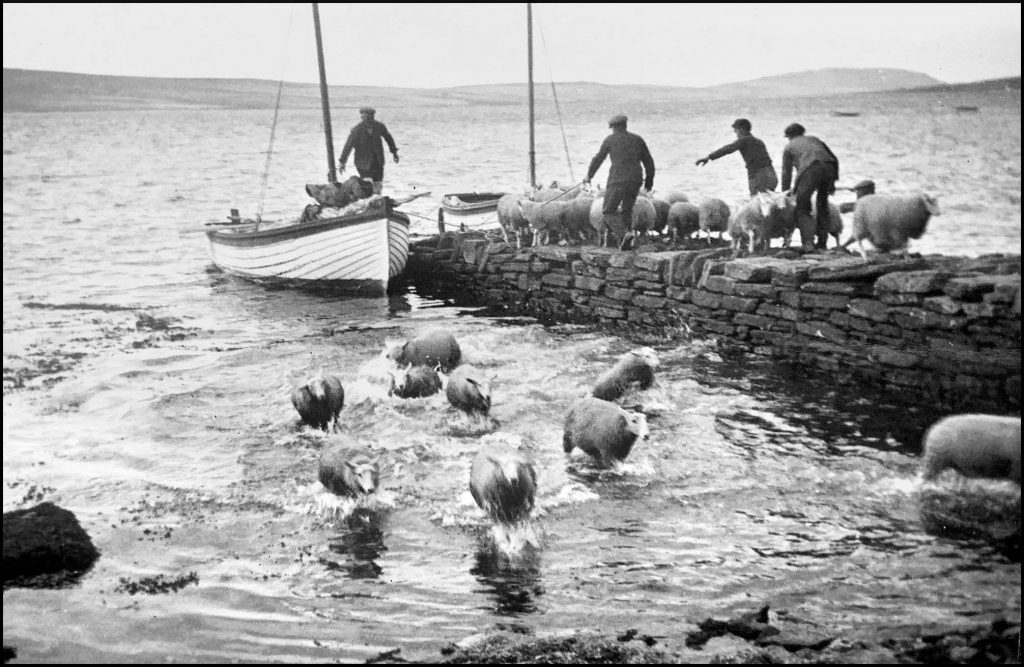
My mother put in a great deal of work. She milked twice a day and made butter and cheese and very often was out helping in the fields.
The children had been at Rendall School.
I got on reasonably well at school. It was a 2 teacher school, with a kind lady for the infants. The headmaster was an alcoholic who for this reason was probably forced to look for a small school in Orkney. He was from Dundee and for a time had sailed abroad. But 2 days every month he was quite drunk and very rarely in school. But he was a clever little man and made up for it when sober.
(I think the Rendall teacher must have been an interesting man; he was liable to illustrate a geography lesson with such words as “I remember, as we steamed into Valparaiso…..”.)
I had a turn of good luck in my last year in Rendall primary school. At that time there was an exam for primary schools in Orkney and Shetland. I sat this exam and was lucky enough to be 2nd in the county. When the minister who had supervised in the exam came to Crook with the prize he told my father that it was on condition that the winner went on for higher education. The nearest school was Kirkwall Grammar School 16 miles away. So I had to stay in digs.
There was of course no hostel at KGS in those days and the digs were pretty grim. For 5 shillings a week they got bed and light (a candle), no heat of course, and “something from the pot” – a share of the family meal. Breakfast was tea and bread, lunch was two caraway biscuits. The boys were often hungry. James William would cycle home to Rendall at the weekends and his mother would feed him up and send some food back with him.
All went well for two years but in the first term of his 3rd year there came the upheaval of the move to Rousay. There was no way he could commute to Kirkwall, he left school and started to work alongside his brother and sister on the farm. But the next summer the family had a visitor from Canada, a relative of James’s mother, Ann Wood, who was from Wyre. He was a man of some education who had made good in Canada (Do we know who this is? William Wood possibly? MG) He took an interest in the boy, particularly when Aunt Maggie showed him some of JWJ’s essays, and when he got back home he wrote to James saying “This boy should be in school”. So back he went.
When I arrived at school after this long absence the headmaster Dr Marwick was stunned. He told me to go to my old class meantime until he made up his mind what to do with me. But he forgot and I struggled along in class all 4th year. Then in the 5th year the Highers were due and I was allowed to sit them. I got Higher English and History, Higher Maths, Higher Chemistry and Physics and Lower Latin. So I got my Highers in 4 years. When Dr Marwick came in with the results he didn’t say well done, he said “Johnston, you lucky dog.“
(Dr Marwick incidentally introduced a lifelong love of poetry; in old age JWJ always enjoyed a good quoting match).
There was no question of going home every weekend. Sometimes he would go home with school friends, sometimes to relations on the Mainland. But he used to tell a story of going home to Rousay, cycling, presumably to Evie, lighting a fire of dry seaweed on the shore and watching the boatman across the water, who had to stop ploughing and unharness the horses before coming down the field and setting out to fetch him. A slow business.
In the holidays there was plenty to do in Rousay. Working on the farm was expected, but he also had a go at painting in water colours, tutored by John Logie.
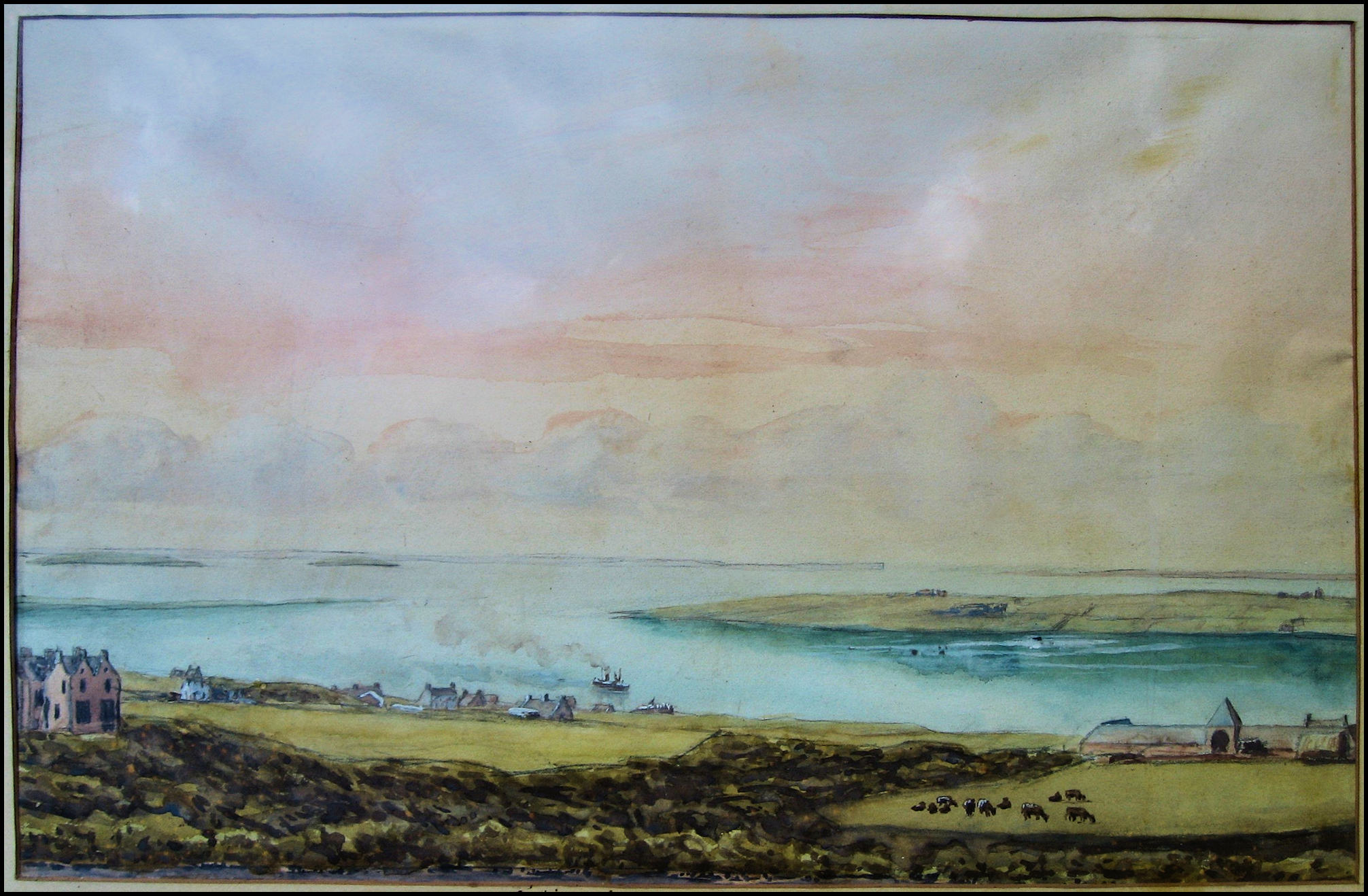
In the evenings the young folk would sometimes commandeer a fiddler and start an impromptu dance. Summer visitors joined in, including sisters Jessie and Nan from Aberdeen who came up every year, their mother was a Sabiston of Wyre ancestry and sister of Bab Harrold. And eventually, after keeping up with the family in Aberdeen, James William married Nan in the island’s only double wedding on July 26th 1933.
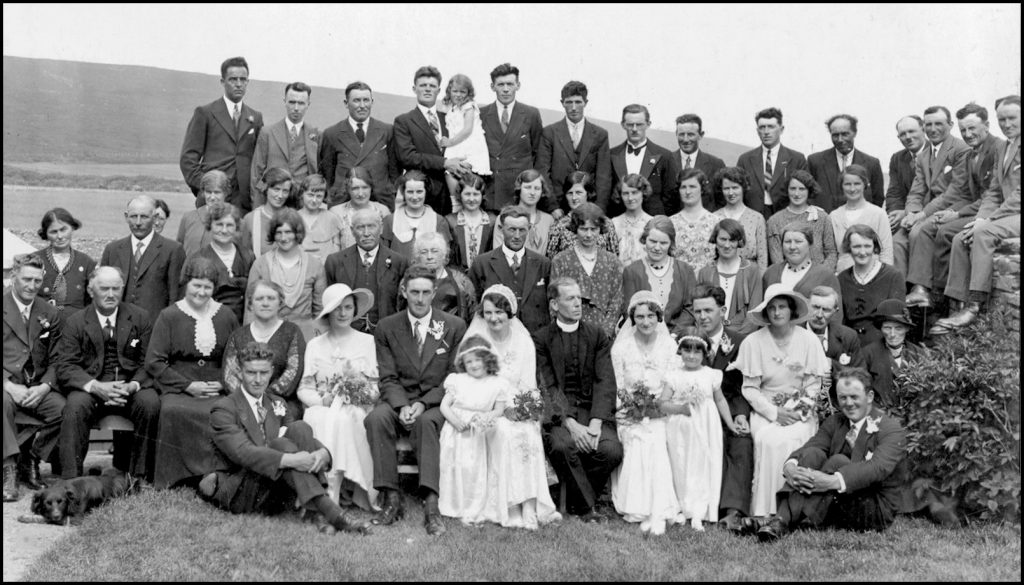
Samuel James Inkster was the son of John Inkster and Jane Irvine, Woo. Violet Johnston was the daughter of James Halcro Johnston, Crook, Rendall, and Margaret Ritch, Binaquoy, Firth, later Trumland Farm. They were involved in Rousay’s only double wedding, for on the same day, July 26th 1933, Violet’s brother James William Johnston married Johan [Nan] Johnston Leslie at Trumland church. Johan’s parents were monumental mason George Gerrard Leslie and Johann Johnston Sabiston, Aberdeen, who was a sister of George Harrold’s wife Barbara Sabiston, and having been a regular visitor to Rousay on holiday since childhood. At the time of the double wedding 27-year-old Sammy was farming the land at Wasdale and 23-year-old Violet was employed as a housemaid. James William was a 26-year-old research worker, living at Strathcona House, Aberdeen, and Johan, also 26 years of age, a ‘clerkess,’ living at Bedford Place in the same city. The ceremonies were conducted by the Reverend Robert R. Davidson, and the witnesses were Sammy’s brother Tommy Inkster, and Isabella Craigie of the Sourin school house, and Robert Ritch Johnston and Robina Ann Johnston, Testaquoy, Wyre.
Front row, from left: 1 George Leslie, Aberdeen, father of Nan. 2 James Johnston, Trumland Farm. 3 Margaret Johnston, Trumland Farm. 4 Mrs Johann Leslie, Aberdeen. 5 Bridesmaid, Isabel Grieve, Fa’doon. 6 Groom, Sammy Inkster, Wasdale. 7 Bride, Violet Johnston, Trumland Farm. 8 Flower girl, Marian Ritch, Aberdeen, a cousin of Violet. 9 Rev. Robert R Davidson. 10 Bride, Johan [Nan] Leslie, Aberdeen. 11 Groom, James William Johnston, Trumland Farm. 12 Flower girl, Joyce Ford, Aberdeen, daughter of Nan’s sister. 13 Bridesmaid, Ina Johnston, Testaquoy, Wyre. 14 John Inkster, Woo. 15 Jean Inkster, Woo. 16 Seated on grass, front left: Best man, Tommy Inkster, Woo . 17 Seated on grass, front right: Best man, Bobby Johnston, Trumland.
Second row: 1 Maggie Johnston. 2 Mr Fraser, Feavel, Birsay. 3 Mrs Fraser, Feavel. 4 Jessie Donaldson, Vacquoy. 5 George Harrold, Russness, Wyre. 6 Barbara Harrold, Russness, Wyre. 7 Jeck Yorston, Drydale, Stromness. 8 Bella Yorston, Drydale. 9 Violet Ritch, Kierfold, Sandwick. 10 Eliza Ritch, Myrtledene, Sandwick. 11 ?. 12 Maggie Jean Ritch, wife of Jamie Ritch and mother of Violet’s flower girl. .
Third row: 1 Clara Johnston [half hidden]. 2 ?. 3 Edda Mainland, Cott. 4 ?. 5 Bella Johnston, Trumland. 6 ?. 7 Lily Fraser, Feaval, Birsay. 8 Louisa Ritch, Braehead, Holm. 9 Anna Mathieson, Sourin Manse . 10 Jessie Ford, Aberdeen, sister of Nan and mother of Nan’s flower girl. 11 Tina Craigie nee Mathieson, Wasbister School. 12 Peggy Marwick, Ronaldsay. 13 Elsie Shearer, Curquoy, later Housegarth, Sandwick. 14 Jeannie Harcus, Knapper.
Fourth/back row: 1 ?. 2 Jim Craigie, Deithe. 3 ?. 4 Ronnie Shearer, Curquoy. 5 Thelma Shearer, Curquoy. 6 Bill Flaws, Hammerfield. 7 John Cormack, Witchwood. 8 David Craigie, Trumland. 9 Jamie Ritch, the youngest of the Ritch brothers, father of flower girl. 10 Willie Inkster, Woo. 11 Sandy Donaldson, Vacquoy. 12 Angus Harcus, Knapper. 13

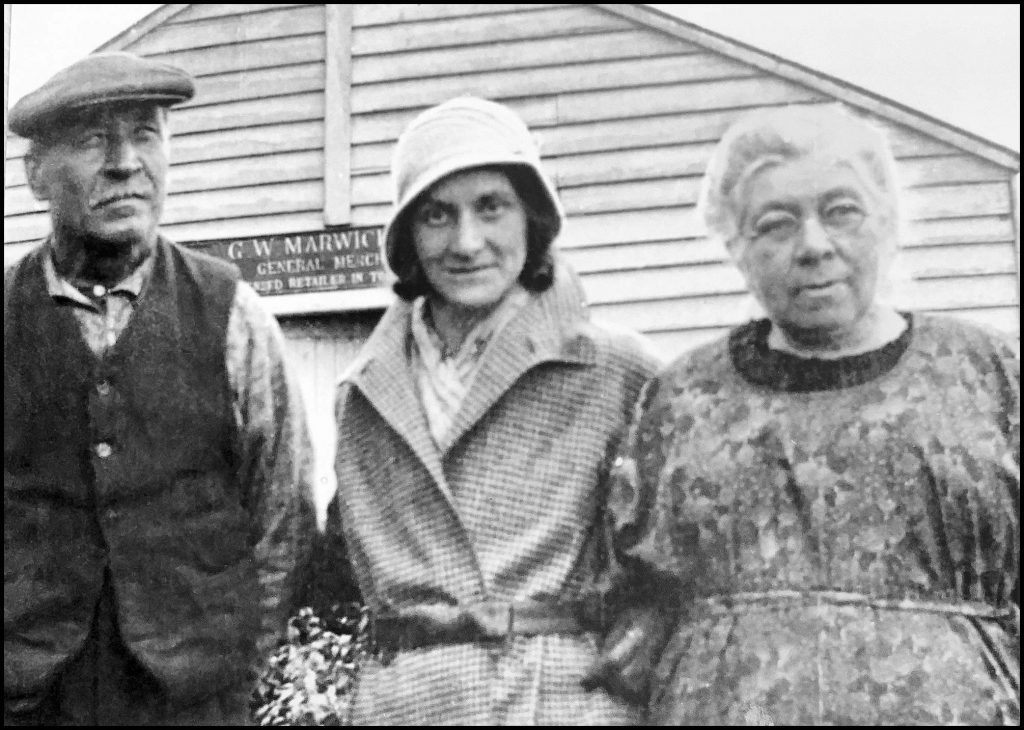
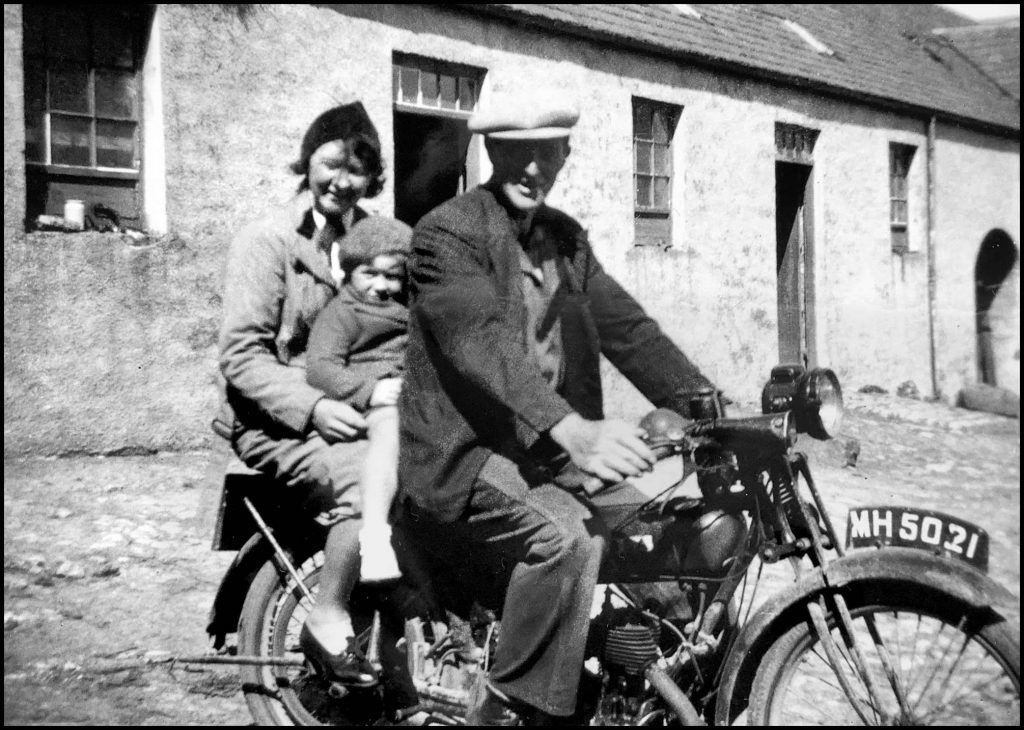
James William went on to Aberdeen University in 1926 to do a BSc (Agri) and on graduation got a job at the Rowett Nutrition Research Institute, then just outside Aberdeen, where he ended up in charge of the poultry department of the attached farm.
Unfortunately the war came in 1939 and it was decided that experimental work would have to be wound up. So I found myself without a job and with a wife and children in a tied house. Many people found themselves in a similar situation. In a desperate moment I offered on a small farm, Greenlands, in Fintray, and was allowed entry in May 1941. So with a month’s salary in my pocket I bought 20 tons of ware potatoes, cut them up and planted 14 acres. Luckily there was a small subsidy put on to grow a potato crop that year.
After struggling through the war he developed a good business selling day old chicks all over the north east (and by plane to Orkney) and when that failed due to the entry of the big firms from the south he moved on to beef cattle and in particular to the Aberdeen Angus Society.

James William’s obituary, printed in The Herald, Scotland’s edition of September 21st 2001, gives further details of his life and times:-
James William Johnston, Honorary president
of Aberdeen-Angus breeders.
Retired farmer and poultry expert James Johnston, 94, farmed at Newton of Fintray, near Aberdeen, for more than 50 years.
Orkney-born Mr Johnston – known to his relatives in the Orkney tradition as James-William and to his friends as Jimmy – hit the headlines in 1951 when his cross-bred heifer, Kilmeny, won the butchers’ cattle championship at the Scottish National Fatstock Show in Edinburgh and went on to win the reserve supreme championship at the Royal Smithfield Show at Earls Court, London.
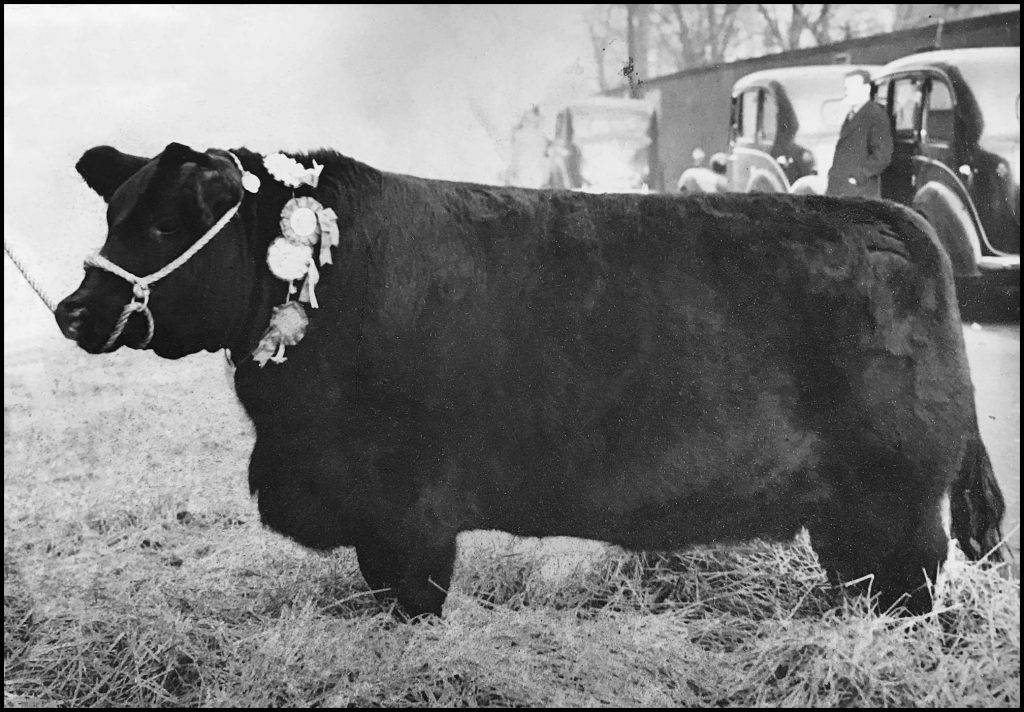
Weight 13 cwts. 2 qrs. 4 lbs. at 2 years 7 months 26 days. – Photo courtesy of Signy Spence
He was born in 1907 in a small, two-roomed cottage on the farm of Crook, Rendall, Orkney, where his family had been tenants since 1840, and moved to Trumland on the island of Rousay in 1922 when his father took on the Home Farm.
After being awarded equal first prize in the Orkney and Shetland Scholarship, he went to school in Kirkwall and then to Aberdeen University where he graduated BSc in agriculture.
Following his graduation, he joined the Rowett Research Institute at Bucksburn as a research worker and carried out an important research project on fowl paralysis which was a major scourge of the poultry industry at that time.
He set up an isolation unit at the Rowett and established that fowl paralysis was a transmissible disease which could be prevented through hygiene and isolation. His findings were published in a paper in the British Veterinary Record.
With wartime cutbacks in research causing considerable uncertainty, he took the lease of Greenlands Farm at Fintray – moving from a comfortable modern house at the Rowett to a house with neither running water nor electricity.
He established an incubator in a shed behind the Banks of Ury Hotel, Inverurie, and built up a business supplying day-old chicks to farmers throughout the north-east – a business which continued for many years.
He bought the adjoining farm of Newton in 1945 and, after being captivated by the view on the south side of Newton Wood, built a house there in 1948 which was his home until he was taken into hospital a few weeks ago.
Apart from his poultry business, his main interest was the bringing on and showing of fatstock, and he also built up a herd of pure-bred Aberdeen-Angus cattle.
At the time of his death, he was honorary president of the North East Aberdeen-Angus Breeders’ Club, in whose activities he had taken a keen and active interest since the club’s foundation in 1972.
He was a regular at the mart at Thainstone, Inverurie, and, along with the late Jim Maitland and the late Willie Lawson, comprised a trio who met for lunch at the mart every Friday and were affectionately known as ”The Last of the Summer Wine”.
ANM Group marketing manager and A-A club secretary Eddie Gillanders, said Mr Johnston would be sadly missed by all his friends at the mart and in the Aberdeen-Angus world.
”Jimmy was a much-loved figure who was always keen to encourage the younger generation and give them the benefit of his long experience,” said Mr Gillanders.
Despite colour blindness, he was naturally artistic and in his younger days painted watercolours which still hang in the homes of friends and family.
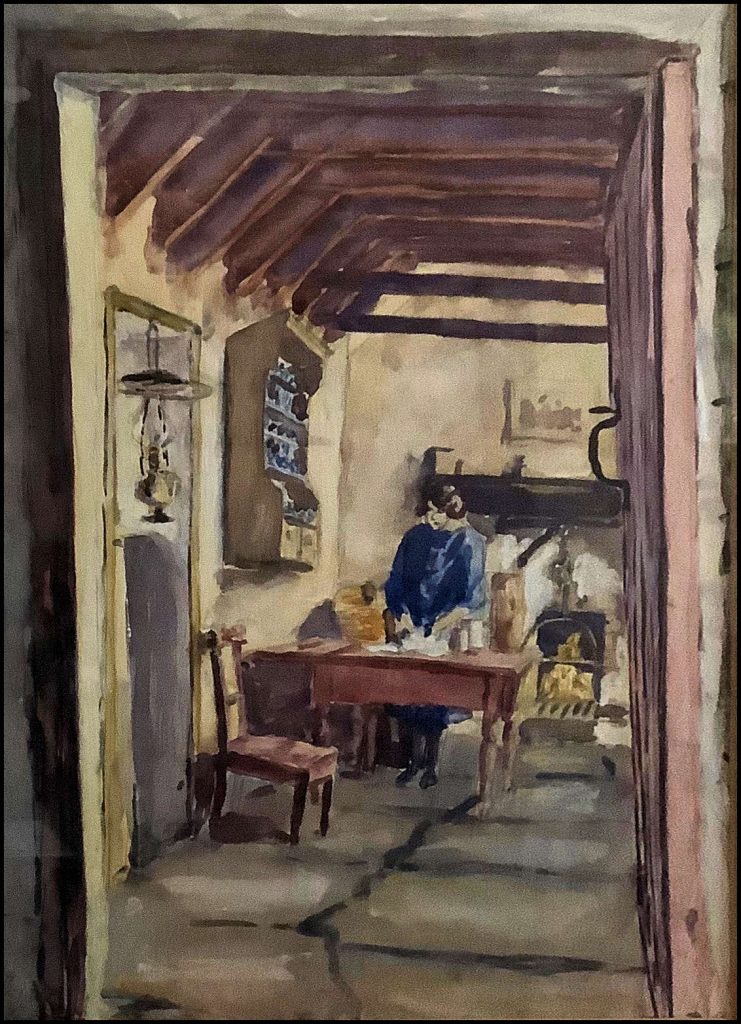
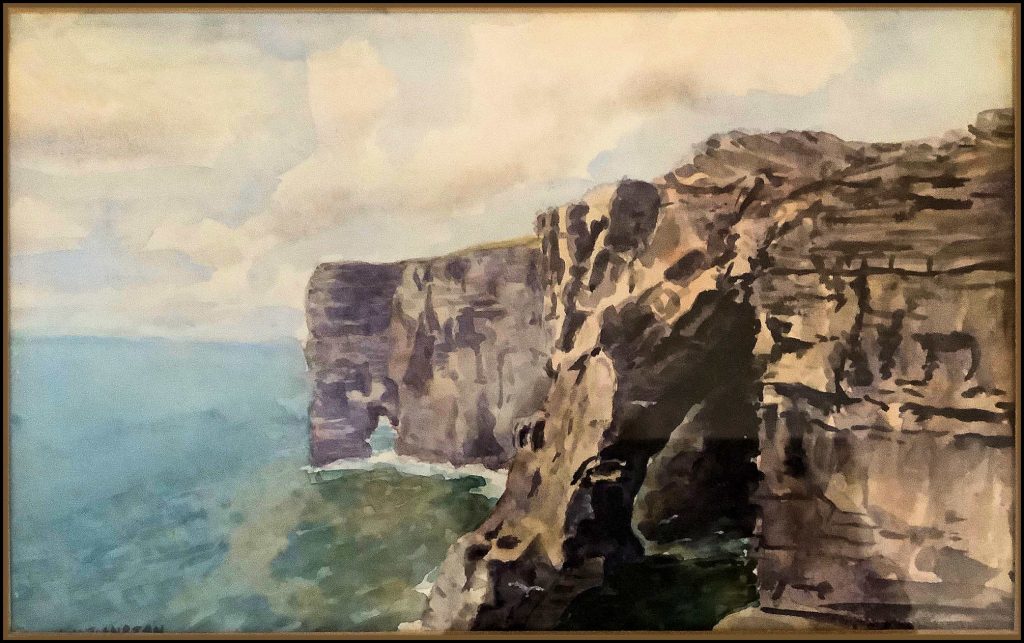
A fondness for poetry stayed with him from school days although – as an Orcadian rather than a Scot – Keats, Shelley, or Wordsworth were more to his taste than Robert Burns.
Mr Johnston was predeceased some years ago by his wife, Nan, whom he married in Rousay in 1933. He is survived by his sons, Robin, who recently retired from Ross Poultry, Hal, an actor currently appearing in the stage musical Fame in London’s West End, and daughter, Margaret, who lives in Coventry. He had seven grandchildren and four great-grandchildren.
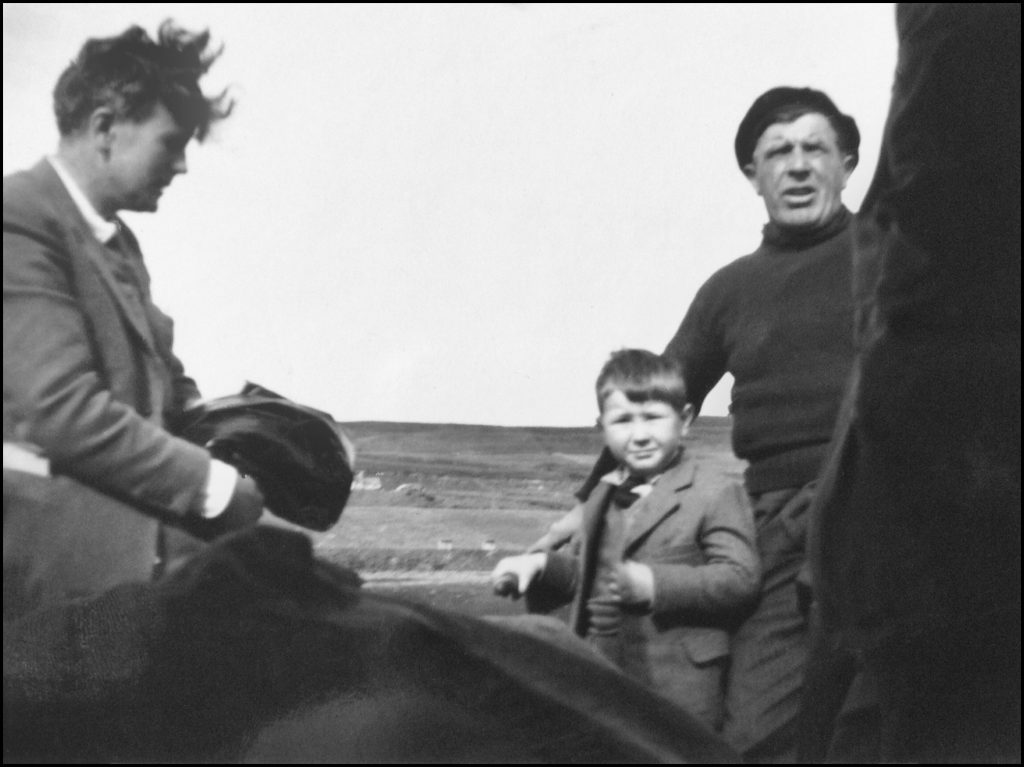

Margaret tells us about James William’s older brother Bobby:-
Bobby was born in 1905. He was said to be very clever but not interested in education; he couldn’t wait to be out working on the farm. He was a stockman at heart, first with the Clydesdales, then with cattle and in his later years he bred Shetland ponies. He was a big man, loud and joking and a born raconteur – he could make a story out of anything. He married Bella Cursiter in 1934; unfortunately they had no children. Bella died in 1959 and he later married Sadie the widow of Billo Gibson. He died in 1971 at the age of 66.
